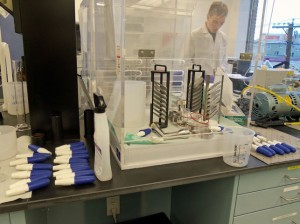The ability of the ARCUS platform to deliver the high, precise dose of L-dopa critical for treatment of Parkinson’s patients was a key factor in the selection of L-dopa as Civitas’s lead product, according to Batycky. “When we started Civitas,” he says, “we were really looking for that first product that we felt could be transformative and fill an unmet need that could not be met not just by any other drug delivery or drug pathway or any other technology.”
Early on, he explains, Alkermes did a lot of screening looking for systemic drugs that would work well as inhaled therapies. And early on, they began to look at using inhalation as a route to the central nervous system because “there’s no more direct path to the CNS than via inhalation.” Soon, however, pulmonary insulin began to take over all of the available resources, and CNS candidates that had been through technical feasibility studies, including L-dopa, were shelved.
Exhubera had demonstrated that simply offering inhalation versus injection as a convenient method of delivery without providing improved safety or efficacy was unlikely to succeed commercially. And drugs with low bioavailability via the inhalation route that required greater amounts of drug without any therapeutic benefit were also clearly going to get a poor reception from payers.

Inhaler testing at the Civitas facility
Unlike inhaled delivery of insulin, L-dopa inhalation therapy had a number of potentially significant benefits compared to oral dosage, the usual form, including good bioavailability and rapid absorption.
With Parkinson’s, patients increasingly experience what is called an OFF state, with slowed motor function and rigidity — to the point where they may completely lose the ability to move — when dopamine levels fall below a certain threshold. In order to regain motor function, patients must take enough L-dopa to raise their dopamine levels back over that threshold.
“The challenge with L-dopa,” Batycky explains, “is that it undergoes food effects,” and for Parkinson’s patients in the OFF state who may have trouble with swallowing and with gastric emptying, the kinetics of oral L-dopa can be extremely variable.
Cmax can fluctuate by an order of magnitude, and it may take an hour or an hour and a half after dosing for the concentration of L-dopa in the blood to reach the level necessary to return a patient’s motor function. Or it might not reach that level at all.
Furthermore, Batycky points out, as Parkinson’s progresses, motor function tends to fluctuate increasingly. Early stage patients may have only one fluctuation per week; but as neurons are destroyed, fluctuations may increase to several times per day and may occur unpredictably.
Under those conditions, every dose of oral L-dopa becomes “a roll of the dice” as to whether the concentration will reach a sufficient level to put the patient in an ON state, according to Batycky. Patients may take oral L-dopa 6-7 times a day and still experience 4-5 hours in an OFF state.
“One of our thought leaders,” he notes, “said you could not actually conceive of a worse molecule to give orally than L-dopa, and you couldn’t conceive of a worse disease to give oral therapy in than Parkinson’s disease, yet that’s the only way that this drug and this disease for the most part is managed. “
Injectable and transdermal formulations of L-dopa are problematic because the drug is incredibly hydrophobic, Batcky says, “you can’t make a solution that’s more than maybe a few mgs/ml, so if you need 50 mgs, it’s just too insoluble.”
But Civitas has found that spreading out 50 mg of L-dopa over the vast surface area of the lung allows for quick dissolution and absorption, with blood levels reaching 80% of maximum value in the first 5 minutes. “It’s night and day compared to what patients are facing now,” Batycky says; “the next question is does that translate into efficacy, and that’s what we’re looking at now.”


